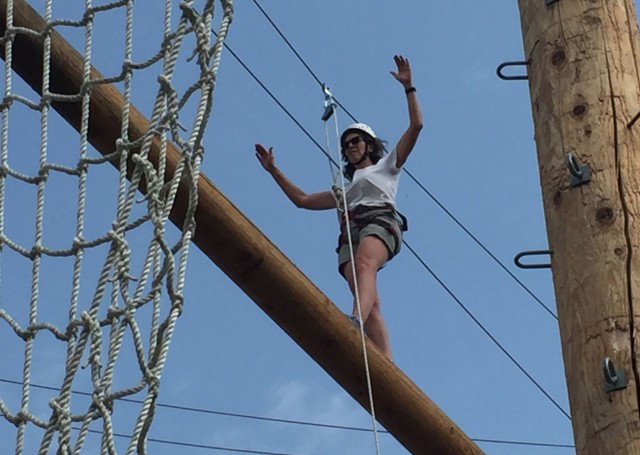My school has the good fortune to have built a challenge course on our campus. It was completed last winter and this summer training was offered to any interested faculty to become a facilitator with the course. I decided to participate in part because I was directly approached and invited by our challenge course manager. (What a good reminder about personal investment and direct asking.) I also knew that my students would be thrilled! I went into it thinking that I would become more comfortable at heights and learn more about all the elements and how they can be used with students.
Wow, was I wrong! Yes, there were practical skills involved. I learned how to self-belay up a pole and safely set a pulley system for a dynamic belay. I learned how to tie specific knots. I learned how belay a person traversing a high element and on a climbing wall. How high? 35 feet off the ground! I even got to play on the elements where I felt comfortable pushing myself. I learned about a couple of the low elements, options for use with my fourth graders. But the key takeaway for me was that our challenge course is simply a tool. A tool much like a classroom, a whiteboard, books, science equipment, maps, everything that we use to guide our students to access the curriculum. It’s an exciting tool for sure, and I have a responsibility to keep the focus on the learning.
What I learned has so much carryover into academic areas and especially into the social-emotional learning that we do. As a facilitator on the challenge course, I must create an environment of emotional and physical safety so that students can thrive. That’s what I do as a classroom teacher. If I don’t enable a student to feel safe, especially emotionally safe, it doesn’t matter how dynamic and exciting my teaching is – little learning will happen.
Choice and Voice are two other key components that work together to help learners develop self-efficacy. I feel strongly about giving kids choices in the classroom and making sure that they have input whenever possible.This isn’t new to me. Somehow, seeing it in this context and experiencing it as a learner this past week, helped me own the understanding in a deeper way than I had before.
I learned about the difference between encouragement and coercion, and how the words can sound EXACTLY THE SAME, depending on who made the choice. That was mind-blowing to think about, especially in connection with how I present and guide our Reading Challenge. I will be spending time in the next couple of weeks before kids arrive thinking about how to better present the Challenge and engage kids in making real-to-them choices so that I can encourage them throughout the year, not make them feel coerced to meet a goal that I set for them. So much of the language that I learned last week around identifying a person’s chosen challenge on the course is directly applicable to goal-setting with kids. I’m excited to use it and increase how much goal-setting and reflection we do as a learning community.
There was so much that I learned, and so much that I still have to digest. I can’t possibly represent it here in a single reflection. I imagine that my learning will be pondered frequently in this blog over the coming year, and I know that the facilitation learning I gained will play a role in my professional goals for this coming year. I’m still churning ideas in my head for how to craft the wording of my goal.
The icing on the cake is the stronger connection that I feel with the nine other faculty members who were in the training with me. I got to know teachers who I rarely see because of the different ages of learners that we teach. We decided to make our group an ongoing Professional Learning Community (PLC) for this school year. We’ll create times to practice our practical skills and talk about how to implement these ideas into our everyday teaching. We’ll celebrate success that happens. We’ll invite each other into our classrooms so that we can refine our skills. We’ll collaborate in ways that we don’t even know right now. It’s exciting, and I’m so glad that I took this class. It was definitely NOT about the climbing!

Self-chosen element + self-chosen goal + personal challenge = celebration!



